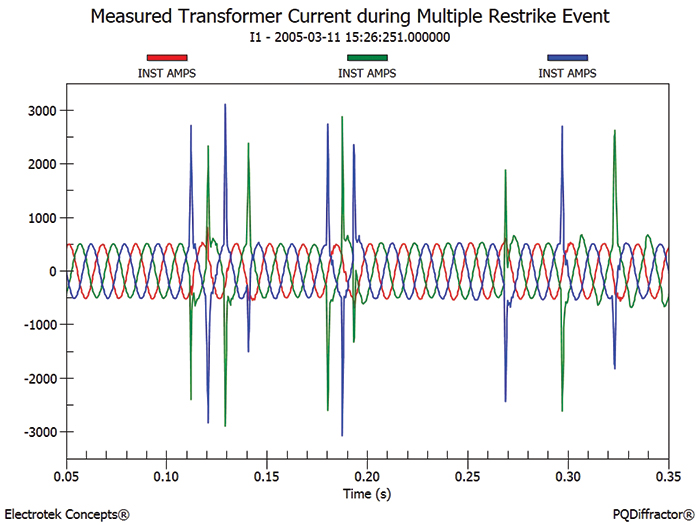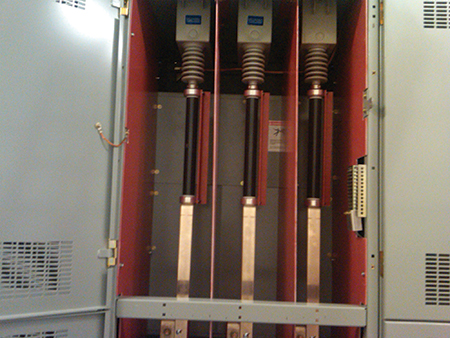Power system transients that are caused by utility switching operations or lightning strikes to electric facilities have significant potential to damage equipment or disrupt operation. High frequency transients have been recognized for quite some time as a threat to electronic loads. Low and medium frequency oscillatory transients, such as utility capacitor bank switching, are usually of modest magnitudes but contain substantial energy, so their effects can be felt quite far electrically from the point of origin. Low frequency transients have been strongly correlated with nuisance tripping of customer power-electronic equipment, such as some types of adjustable-speed drives.
Transient voltages and currents are caused by sudden changes within the electric power system. Opening or closing of a switch or circuit breaker causes a change in circuit configuration and the associated voltages and currents. A finite amount of time is required before a new stable operating point is reached. Lightning strokes to exposed transmission or distribution circuits inject a large amount of energy into the power system in a very short time, causing deviations in voltages and currents which persist until the excess energy is absorbed. Both of these events cause a temporary departure of system voltage and current from their normal steady-state sinusoidal waveforms. All transients are caused by either connection or disconnection of elements within the electric circuit or injection of energy due to a direct or indirect lightning stroke or static discharge.
Transient Simulation Tools
Power system transient studies are completed using electromagnetic transients programs, such as EMTP-RV, PSCAD/EMTDC, and ATP. Computer simulations provide a convenient means to characterize transient events, determine resulting problems, and evaluate mitigation alternatives. Occasionally, the simulations are performed in conjunction with system monitoring for model validation and identification of important customer power quality problems. The complexity of the computer simulation models generally depend on the system characteristics and the transient phenomena under investigation.
EMTP-RV is a sophisticated program for the simulation of electromagnetic, electromechanical and control system transients in multiphase power systems. The program has a wide variety of modeling capabilities encompassing electromagnetic and electromechanical oscillations ranging in duration from microseconds to seconds. EMTP-RV is also used to study harmonic interactions in the frequency domain, including impedance frequency scans, harmonic distortion, and IEEE Std. 519 compliance analysis.
Types of Transient Studies
EMTP-RV is used to study potential problems associated with utility and customer equipment interactions. These studies include analysis of the methods for controlling transients based on economic, control, and technical considerations. Mitigation equipment specifications are determined for the required switching devices, current-limiting reactors, surge arresters, and customer surge control devices. Power system transient studies are needed to investigate utility transmission system expansion concerns including insulation withstand levels, switchgear capabilities, protective device energy duties, and system harmonic considerations. These issues should be extended to include utility distribution systems and customer facilities. Representative transient studies that can be completed using EMTP-RV include:
- Switching Surge Analysis
- Capacitor Bank Switching (Energizing and Switch Restrikes)
- Shunt Reactor Switching
- Transmission Line and Distribution Feeder Energizing
- Lightning Surges (Backlash)
- Transient Recovery Voltage (TRV) Analysis
- Arrester Duties and Insulation Coordination
- Wind Plant Temporary Overvoltages (TOVs) during Single-Phase Faults
- Transformer Switching and Dynamic Overvoltages
- Ferroresonance / Parallel Linear Resonance
- Motor Starting
- Voltage Notching
- Customer Adjustable-Speed Drive (ASD) Motor Transients
- Vacuum Circuit Breaker Switching (Current Chopping and Pre- Strikes)
- Power-Electronic Device Switching (Power Supply Inrush Currents)
- Outrush Reactor Transient Recovery Voltage Analysis
Capacitor bank switching studies often receive special consideration because the capacitor bank energizing transient is one of the most frequent utility switching operations and it can produce high phase-to-phase transformer overvoltages, excite circuit resonances, or cause problems with sensitive customer equipment. The frequent switching of utility capacitor banks coupled with sensitive customer end-use equipment has led to a heightened awareness of several important power quality concerns which include magnification of capacitor bank switching transients and nuisance tripping of power electronic-based customer loads.
Utility Capacitor Bank Switching Studies
Recent and upcoming power plant retirements are resulting in a need to reinforce our transmission systems. One measure being adopted is to install additional reactive power in the form of capacitor banks that often require detailed harmonic or transient simulation studies to assure a successful design.
The analysis of utility transmission capacitor banks often includes measurements and computer simulations for studying application considerations that include capacitor bank configurations, insulation withstand levels, switchgear capabilities, grounding, overcurrent protection, overvoltage protection, energy duties of protective devices, and unbalance detection.
The most common methods for controlling utility capacitor switching transients include switching control (e.g., synchronous closing, pre-insertion inductors/resistors), fixed series inductances, and MOV surge arresters. The application of transmission and distribution system capacitor banks has long been accepted as a necessary step in the design and operation of electric power systems. Design considerations often include traditional factors such as voltage support, power factor, and released capacity. However, as customer systems evolve through the use of power electronics, future capacitor bank designs should also consider power quality.
The utility capacitor bank switching study should include a transient analysis of overvoltages and overcurrents during capacitor bank energizing and capacitor bank switch restrike events. The primary issues evaluated during the study include:
- Evaluation of transient overvoltage magnitudes for normal capacitor bank energizing operations, including the effects of other capacitor banks and system loads.
- Evaluation of the effectiveness (control of energizing transients) of various transient control methods (e.g., pre-insertion inductors/ resistors, synchronous closing control, etc.).
- Evaluation of arrester duties during capacitor bank switch restrike conditions.
- Evaluation of inrush currents for normal and back-to-back switching operations.
- Evaluation of outrush currents for nearby fault conditions.
- Evaluation of capacitor switching transients on lower voltage systems.
- Magnified transients at lower voltage distribution buses and within customer facilities.
- Nuisance tripping of adjustable-speed drives.
- Evaluation of system frequency response characteristics (resonances).
A utility capacitor bank study is needed to determine recommended equipment ratings and requirements for protecting against excessive transients for the power system and to also present guidelines for applying transmission capacitor banks with respect to overvoltage mitigation. The study includes the following equipment recommendations:
- Options for current limiting reactors for controlling inrush and outrush currents.
- Requirements for capacitor switching devices, including the effectiveness of transient overvoltage mitigation techniques (i.e., synchronous closing control, pre-insertion resistors/inductors).
- Arrester requirements associated with a capacitor bank switch restrike event.
- Requirements to protect against excessive transients at lower voltage capacitor banks, including capacitor switching controls, surge arresters, reactors, or capacitor size limitations.
- Requirements to protect against excessive transients at low voltage adjustable-speed drives, including capacitor switching controls, and reactors.
- Guidelines for developing a standard capacitor bank design with respect to overvoltage mitigation, reactor requirements, and surge arrester applications.
Case Study - Utility Capacitor Bank Switch Failure Investigation
Power system apparatus, such as switchgear, capacitor banks, and surge arresters may be exposed to various types of transients. Transients from restrikes during vacuum switch opening may cause problems for electrical equipment because they can cause local overstressing of the insulation system and exceed surge arrester energy ratings. Capacitor bank switch restrikes often produce high transient voltage surges that result in severe energy duties for adjacent arresters or damage unprotected equipment.
A transient investigation was completed for a utility in Kansas. The primary purpose of the study was to investigate a capacitor bank vacuum switch failure that occurred during a multiple restrike event on an ungrounded 7,800 kVAr, 34.5kV capacitor bank that was protected with a 27kV MOV arrester. A large number of customer power quality complaints recorded during the capacitor bank switch failure included adjustable-speed drives and HVAC equipment tripping due to the resulting secondary transient overvoltages.
The principal objectives of the study were to determine transient overvoltages and evaluate mitigation alternatives for vacuum switch restrike transients (refer to Figure 1) that were believed to have caused the capacitor bank switch failure.
A capacitor bank switching device de-energizes a capacitor bank at a current zero. Since the current is capacitive, the voltage at the time of current interruption is at a system peak. Successful interruption depends on whether the switch can develop sufficient dielectric strength to withstand the rate-of-rise and the peak recovery voltage. For grounded-wye capacitor banks, two times (2.0 per-unit) the system peak voltage will appear across the switch contacts one-half cycle after interruption. If the switch cannot withstand this recovery voltage, the switch will restrike.
During normal grounded-wye capacitor bank de-energization, the capacitor bank current is interrupted at the peak system voltage thus leaving a 1.0 per-unit trapped charge on the capacitor bank. This trapped charge results in an offset in the transient recovery voltage that reaches a magnitude of 2.0 per-unit one-half cycle after opening. Significant transient voltages can occur if the switch restrikes during clearing. The worst restrike transient occurs when twice the system peak voltage appears across the switch contacts. Theoretically, in this case, the magnitude of the transient voltage approaches 3.0 per-unit.
The transient voltages on a capacitor bank and the recovery voltages across the switch can be reduced by installing arresters on the capacitor bank side of the switching device. If the switch is rated for the recovery voltages involved, then the arresters can be located on either the capacitor bank side or source side of the switch. Connecting arresters line-to-ground on an ungrounded-wye capacitor bank does not necessarily limit the voltages trapped on the capacitor units to the arrester’s protective level.
Since a restriking capacitor bank switching device can result in transient voltages that may result in severe arrester energy duty or equipment damage, it is desirable to choose a switching device that will minimize the possibility of restrike. Since all switching devices have some probability of restrike, the effects of restrike events should be investigated in the transient study.

(click to enlarge)
Figure 1 – Measured Transformer Secondary Current during Capacitor Bank Vacuum Switch Failure
Case Study - Hospital Transformer Failure Transient Investigation
High-frequency transients and very steep overvoltages may cause problems for electrical equipment because they can cause local overstressing of the insulation system. Vacuum circuit breaker (VCB) opening-and-closing operations are a significant source of these high rate-of-rise (dv/dt) transients. In addition, dry-type transformers and motors are often more vulnerable to these transients due to their lower insulation level (BIL) ratings.
A high-frequency transient investigation was completed for a medical center in California. The purpose of the study was to investigate a transformer failure that occurred during commissioning of the facility. The principal objectives of the study were to determine transient overvoltages and evaluate mitigation alternatives for vacuum circuit breaker current chopping and pre-strike transients that were believed to have caused the transformer failure.
The study included analysis of MOV surge arresters and other mitigation alternatives (e.g., R-C snubbers). Based on the analysis completed during the study, the hospital installed R-C snubbers (refer to Figure 2) at the switchgear terminals of the distribution circuits where the transformers were being switched. Properly-designed R-C snubbers reduce the initial rate-of-rise of the transient voltages, which is beneficial because severe dv/dt transient voltages can damage the first few turns of insulation of dry-type transformers and motors or excite internal transformer resonances producing severe overvoltages.
Vacuum circuit breakers are understood to be capable of initiating a phenomena described as current chopping. The physics of the vacuum circuit breaker allow for a smaller space to be utilized in the interruption of current in a vacuum. It is well-known that these devices can interrupt (chop) current. This is a different behavior than typical air circuit breakers, which normally allow current arcing following contact separation until a natural zero crossing occurs.
The current chopping phenomenon is generally not troublesome, however, there are specific circuit configurations that can cause problems. The most common configuration involves using vacuum interrupters to de-energize unloaded transformers or other highly inductive circuits. In this case, the inductive current to the transformer is interrupted, possibly causing high transient overvoltages. The current chopping analysis showed that severe transient overvoltages will occur if the vacuum circuit breakers chop current during opening.
Pre-strikes are a breakdown of the vacuum dielectric during closing of a vacuum circuit breaker. A pre-strike occurs when an arc current flows for a short period-of-time before mechanical contact closure. The pre-strike phenomenon is very complex and difficult to predict. The transient currents and voltages are dependent on many factors, such as circuit breaker characteristics, dielectric properties, surge impedance of the circuit components, and high-frequency current interrupting capability.
Transient voltages during pre-strikes are a result of the interaction (resonance) between a transformer inductance and a capacitive network. The susceptibility to the resonant frequency phenomena depends on cable lengths and other capacitive parameters and on the transformer inductance. The pre-strike analysis completed during the study showed the potential for high rate-of-rise transient voltages if the vacuum circuit breaker pre-strikes during closing.

Figure 2 – R-C Snubber Installed at Customer Facility
About the Author
 Thomas Grebe, P.E. is a Principal Consultant at EnerNex. His areas of expertise include power system and power quality analysis, transient analysis, harmonic monitoring and analysis, and utility capacitor bank application studies. His experiences include completing numerous utility power system studies and research projects for organizations including CEATI, EPRI, NRECA, and TVPPA. Tom has over twenty-five years of application experience using the Electromagnetic Transient Program (EMTP-RV) and PSCAD transient simulation programs.
Thomas Grebe, P.E. is a Principal Consultant at EnerNex. His areas of expertise include power system and power quality analysis, transient analysis, harmonic monitoring and analysis, and utility capacitor bank application studies. His experiences include completing numerous utility power system studies and research projects for organizations including CEATI, EPRI, NRECA, and TVPPA. Tom has over twenty-five years of application experience using the Electromagnetic Transient Program (EMTP-RV) and PSCAD transient simulation programs.
Tom served as Conference Secretary and Local Organizing Committee Chairman for the 1997 International Conference on Power System Transients (IPST) Conference that was hosted by the University of Washington. The IPST Conference was created with the goal of promoting the study of power systems transients by offering a platform of scientific and technical excellence for its presentation. Tom is currently an IPST Steering Committee member.
Tom is a Senior Member of the Institute of Electrical and Electronics Engineers (IEEE) Power and Energy Society (PES), Chairman of the IEEE Working Group on Capacitor Technical Papers, and is Past Chairman of the IEEE PES T&D Committee and IEEE Capacitor Subcommittee. Tom is registered as a Professional Engineer in the State of Virginia.







